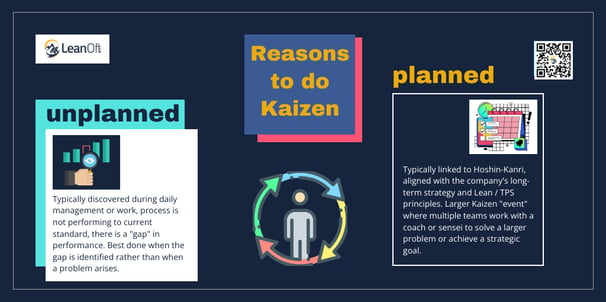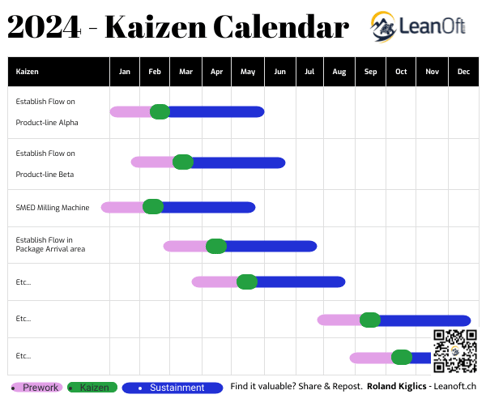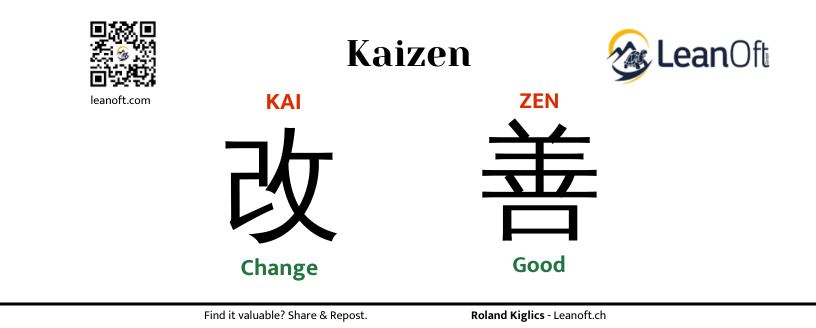Starting with Kaizen: Kaizen vs. Kaizen “events” vs. Action Workouts
Navigating from Brainstorming to Try-Storming and taking actions. The Differences Between Planning and Action.
KAIZENCONTINUOUS IMPROVEMENTSMES & STARTUPSLEAN MANAGEMENT CONSULTING
Roland Kiglics
9/10/20249 min read
Introduction
I had the unique opportunity to participate in several Shingijutsu Consultant-led Kaizens. These were led by Shingijutsu experts with decades of direct Toyota experience and knowledge, and provided a first-hand learning experience that significantly deepened my understanding of what Kaizen really means and how it's applied in practice.
Using this knowledge, I have planned, led and facilitated hundreds of Kaizens with diverse groups of people over the years. I have contributed first-hand to the integration of Kaizen and Lean/TPS principles into the everyday life of the organisation, benefiting everyone from customers to front-line workers on the shop floor or in the offices.
So what is Kaizen? Why should you do it? I have seen and heard so many descriptions of the word; Kaizen. Kaizen seems to be a term that often causes confusion and ignites heated debate. Is it a one time action? Is it an ongoing process? Is it a scheduled event or an ad-hock action? Throughout my career I have come across many different improvement methods, each with its own name and approach. These include:
Action Workouts (AWO)
Improvement Projects or Continuous Improvement Projects
Kaizen Weeks or Kaizen Events
Kaizen
Are There Differences? Yes, there are significant differences among them. Let’s see one by one what they actually are.
Action Workouts
Action Workouts (AWO) come from Lean Six Sigma. It is usually a 'planning session' where teams, usually made up of employees, brainstorm to identify potential solutions, plan, assign responsibilities and set deadlines. This approach is often favoured by traditional management, who want to ensure that the team's plan 'fits the narrative' and the current working environment. However, these projects are often delayed by requests for more data and multiple layers of review, only for some of them to be cancelled later. And at that point nobody has done anything, this is just a 'plan', an action to be taken later. How often have you seen well-intentioned projects disappear before they even begin or it takes “forever” to get done? While AWOs can be beneficial, they are not the same as Kaizens.
What is Kaizen
改 善
The word 'Kaizen' translates from Japanese as "change for the better" and is used in Japan to describe a daily practice of continuous improvement. It is perhaps best described by Chihiro Nakao, who was directly trained and mentored by Taiichi Ohno and went on to co-found the Shingijutsu Co., Ltd (1987), and who said that "Kaizen means taking action; go to the genba now, deal with the facts now. Always take action; that is the key"[1]. However, it is more than just doing though. When an organisation or individual practices Kaizen, they are always in the process of learning by doing. Therefore, Kaizen is also learning and improving ourselves, increasing our knowledge.
But is it realistic to expect an entire organisation to adopt daily Kaizen practices immediately? If it were that easy, there would be many more stories of successful business transformation than of those who tried and failed miserably. There are, of course, a number of factors that contribute to this. In my experience, one of the contributing factors is the unrealistic expectation that an entire organisation (regardless of size) will start doing daily Kaizen just because someone says it is "good for you". Especially if they've been practising traditional management or some variant of Sick-Sigma or Lean-Six-Sigma or something... It's not going to happen. If it does, please invite me to see it, because that would be the 8th wonder of the world and I would definitely be interested in learning about it.
Oh, you say you are not a CEO yet, you do not have big influence. Well, in that case, do the best you can within your span of influence and do Kaizen where you can. Start following Lean / TPS practices within your reach and lead by example. If you get it right, others will want to follow, or you will be ridiculed. Either way, don't give up, just do it. It really is worth it. Be careful though! Do not force people to do it, if you have no influence and you try to force people to do Kaizen or Lean/TPS in general... I guarantee you will not make any friends.
“kai” “zen”
The aim of Kaizen, in the words of Chihiro Nakao: “Take action NOW, do it NOW, deal with the problems NOW.”
More often then not, it needs a good kick-off or kick-start.
What can you do, you ask? If you are someone with more influence, what you can do is to make Kaizen deliberate. Schedule it and get teams of 6-8 people involved. Learn how to do it together. (ok, there is a bit more to it than that, :) read on...)
However, as you are only starting learning Kaizen, it is no harm to apply Kaizen in such a concept. Keep in mind though, with time, this approach should fade and as people are trained in Standard Work, Problem Solving and other Lean/TPS concepts, Kaizen should really became what it is, an activity for everybody, everywhere, everyday. After reduced in frequency and importance in a more advanced environment, Kaizen “events” can serve as a platform for teams to solve the bigger, more complex problems that cannot be solved by an individual or a small team in a short period of time. (more on this later in another post)
Kaizen is not only for people in a manufacturing environment or on the shop-floor either. Management and people working in offices must participate too. In fact, they have to be just as active as anybody else.
For companies starting their Lean/TPS journey, Kaizen "events" or "weeks" are an effective and practical introduction to the principles of continuous improvement, empowering multi-disciplinary teams to make improvements and rapidly transform any organisational process.
This Kaizen "event" or "week" is typically a planned 3-5 days, activity packed, cross functional team exercise. It is also a learning opportunity for everyone involved. This does not mean training in a classroom, sitting and listening to a single person give a power point presentation. On the contrary, it is learning by doing, hands-on learning or try-storming in genba where the work is being performed. (Read more about Moonshining & try-storming in my previous post.)
Another important factor in Kaizen is Standard Work. As Taiichi Ohno, the father of the Toyota Production System, said: "Without standards there can be no improvement". (more about this in a post later)




What do I mean by schedule it or plan it? I mean, literally, to schedule Kaizen in the calendar. This is why you sometimes hear the term Kaizen "event", Kaizen "week" or Kaizen "workshop".
It is very important to emphasise and remember though! Kaizen ≠ Kaizen event nor Kaizen workshop nor Kaizen-week.
Be clear about where you are today (what is your current standard and where are you performing compared to it)
Be clear about where you want to be (gap created or gap to standard)
Identify & make improvements to drive out waste (problem solving, try storming)
Re-set your standards to the new way and monitor progress
Rins-repeat
High-level, Key Stages of Kaizen
Why Kaizen "events" Matter – Benefits of Kaizen
Can Kaizen "events" serve as a bridge to a real Kaizen culture, where Kaizen is part of everyday life and not just a "project"?
I would argue that in most cases the answer is yes. While kaizen events are not identical to Kaizen, they do provide a structured way to transform the organisation and its culture, as my personal experience and examples from Danaher, Wiremold[2] and a few others have shown.
While many benefits of Kaizen are well-known, such as increased efficiency and reduced waste, there are several less common benefits that organisations may experience:
Increased employee involvement and greater job satisfaction: Kaizen is a team sport. Involve, encouraged and empower people to make improvements. It leads to people being more invested in the success of the organisation.
Better Problem-Solving Skills: I've seen it first hand, and having facilitated Kaizen “events” myself, I know how fantastic they are for training people in problem-solving methods that can be put into practice immediately. The combination of theory and immediate practical application enables a better understanding of the theory and develops better problem solving skills through the feedback loop experienced through trial and error by the person. This knowledge can then be applied by employees to various challenges beyond their immediate work tasks. Ultimately, this gives them the opportunity to solve their own problems, leading to a culture of continuous problem solving.
Innovation Stimulation: The culture of continuous improvement also encourages employees to think creatively and come up with better and more innovative solutions that may not have occurred in a more static environment.
More flexible workforce: Kaizen “events” give people the opportunity to learn about processes that they were previously unfamiliar with. It allows the organisation to train people in multiple processes so they can perform a greater variety of tasks (yes, even in a unionised environment if done right), allowing the organisation to be more responsive to changes in demand.
Improved Information Flow: A multi-disciplinary, cross-functional team is essential for a good Kaizen “event”. With this in place, and with the right facilitation, people feel empowered to have a more open dialogue and better collaboration between team members, breaking down silos and improving not only overall communication, but the flow of information throughout the organisation.
Improved Focus on the Customer: The whole point of doing Kaizen is to improve the way we work and communicate. To improve the flow of materials and information. But why? Because if it is all better and constantly improving, we can serve our customers better, which is why we are in business in the first place. Yes, it makes financial sense too. Happier customers mean more business. Or is that too naive to think?
Knowledge Retention: Kaizen practices help to document processes after each improvement, as a new standard work is required to ensure that a new process is followed and sustained. This also ensures that valuable knowledge is retained within the organisation as people come and go.
Another important benefit I already covered above is delivering rapid results: A Kaizen “event” is a focused and intensive action packed doing “event”. It allows teams to quickly identify and implement improvements, leading to tangible benefits within a short timeframe.
Case Studies
Finally, I would like to give you two examples of what the results of a Kaizen look like. You and your team can do it too. Just give it a try.
In one of my previous post I showed what a good kaizen looks like with results. The team improved their workplace and optimised the hospitalisation board to better show what was happening with each animal. Read the story here: Hospitalisation Board Improvement - Visual Management
In another case, the team had a problem finding tools and decided to use visual management to make their work easier, identify each tool and their location to eliminate the constant question of "where is my tool?" Read the full story here: Appointment Room Tooling Improvement - Visual Management & 5S
Although some efforts fail, others transform organisations and people. In my experience, Kaizen 'weeks' are an effective way to kick-start change. These enable rapid, impactful change and help to foster a culture of continuous improvement within organisations. Kaizen “events” are not a “tool” to implement. Even if your organization isn’t fully committed to Lean/TPS, regular Kaizen “events” are preferable to traditional project management. How often do we find ourselves stuck in outdated management practices[3]? Importantly, the use of Kaizen “events” contributes significantly to cultural change within an organisation. Over time, as more and more people in the organisation are involved and trained in problem solving, the mentality changes. With right leadership, Kaizen “events” can engage, motivate and empower people to pursue continuous improvement in their work.
Conclusion
References
Bob Emiliani, Katsusaburo Yoshino, Rudy Go (2015). Kaizen Forever: Teachings of Chihiro Nakao. p4. Wethersfield, Connecticut, USA: CLBM, LLC.
Barney Art (2013). The Lean Turnaround: How Business Leaders use Lean Principles to Create Value and Transform Their Company. New York, USA: McGraw-Hill.
“The Backstory – The Triumph of Classical Management“ by Emiliani, Bob, 8, February 2018
Further reading
Bob Emiliani, Katsusaburo Yoshino, Rudy Go (2015). Kaizen Forever: Teachings of Chihiro Nakao. Wethersfield, Connecticut, USA: CLBM, LLC.
Barney Art (2017). The Lean Turnaround Action Guide: How to Implement Lean, Create Value, and Grow Your People. New York, USA: McGraw-Hill.
“Ask Art: What Was Danaher Like In the Early Days of Lean?” By Barney, Art, 17 September 2020
Video to watch
“Exploring the gaps in people’s understanding of Kaizen” by Emiliani Bob, (2024)
Book Your First Consultation
Get in touch to discuss how LeanOft can help you today.
Get to know us
Do you prefer personal contact over a form? Take the opportunity and write an email to get to know LeanOft and the people behind it.
Quick and Direct Access
Give us a call:
+41779456508
LeanOft GmbH provides hands-on, People-Centered Lean implementation support and problem solving for organizations that want to be better tomorrow than they are today.
LeanOft GmbH is primarily based in Switzerland and is working with companies in Switzerland and in Europe
Follow us
COPYRIGHT © 2025 LeanOft GmbH


+41779456508


